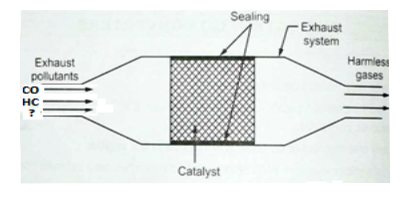Assertion : Through the use of catalytic converters, unburnt hydrocarbons are changed into carbon monoxide which in turn is changed into nitrogen oxides and water.
Reason : Motor vehicles equipped with catalytic converters should use leaded petrol to protect the catalyst from degradation.
The correct Answer is:D
A catalytic converter is a vehicle emission control device that converts toxic pollutants of the exhaust gas into less toxic pollutants by catalysing a redox reaction. Catalytic converters, having expensive metals namely platinum-palladium and rhodium as the catalysts, are fitted into automobiles for reducing emission of poisonous gases. Rhodium is used as reduction catalyst, palladium is used as an oxidation catalyst, and platinum is used both for oxidation and reduction. As the exhause passes through the catalytic converter, unburnt hydrocarbons are converted into carbon dioxide and water, and carbon monoxide and nitirc oxide are changed to carbon dioxide and nitrogen gas, respectively. Motor vehicle equipped with catalytic should use unleaded pertol because lead in the pertol inactivates the catalyst.
Topper's Solved these Questions
Similar Questions
Knowledge Check
vehicles treated with catalytic converter should use lead free petrol because
Alead enhances the activity of catalytic converterBlead inactivates the catalystClead oxidises the hydrocarbonsDlead attracts pollutants from airMotor vehicles equipped with catalytic converter are advised to use unleaded petrol because
Alead is a heavy metalBlead causes inactivation of catalystClead decreases the efficiency of vehicleDlead increases burning of petrol(A) : Motor vehicles equipped with catalytic converter should use unrelated petrol.
(R) : Lead in petrol inactivates the catalyst.AIf both (A) and (R) are true but (R) is not the correct explanation of (A).BIf both (A) and (R) are true and (R) is the correct explanation of (A).CIf (A) is true but (R) is false.DIf both (A) and (R) are false.

Observe the diagram of the catalytic converter and answer the questions which follow:
(a) Name any two metals used as catalyst in the catalytic converter.
(b) Name the gases that are released after passing the exhaust hydrocarbons through the catalytic converter.
(c) Name the other poisonous gas which is missing (?) in the exhaust pollutant of an automobile in the above diagram?
View SolutionSince coal and petroleum have been formed from bio-mass, in addition to carbon, these contain hydrogen, nitrogen and sulphur. When these are burnt, the products are carbon dioxide, water, oxides of nitrogen and oxides of sulphur. When combustion takes place in insufficient air (oxygen), then carbon monoxide is formed instead of carbon dioxide. Of these products, the oxides of sulphur and nitrogen and carbon monoxide are poisonous at high concentrations and carbon dioxide is a greenhouse gas. Another way of looking at coal and petroleum is that they are huge reservoirs of carbon and if all of this carbon is converted to carbon dioxide, then the amount of carbon dioxide in the atmosphere is going to increase, leading to intense global warming. Thus, we need to use these resources judiciously.
What is the common source of carbon dioxide, water, oxides of nitrogen and suplhur in the air ?
View SolutionSince coal and petroleum have been formed from bio-mass, in addition to carbon, these contain hydrogen, nitrogen and sulphur. When these are burnt, the products are carbon dioxide, water, oxides of nitrogen and oxides of sulphur. When combustion takes place in insufficient air (oxygen), then carbon monoxide is formed instead of carbon dioxide. Of these products, the oxides of sulphur and nitrogen and carbon monoxide are poisonous at high concentrations and carbon dioxide is a greenhouse gas. Another way of looking at coal and petroleum is that they are huge reservoirs of carbon and if all of this carbon is converted to carbon dioxide, then the amount of carbon dioxide in the atmosphere is going to increase, leading to intense global warming. Thus, we need to use these resources judiciously.
of the above mentioned gases, which one is the green house gas and what does it lead to ?
View SolutionWhich of the following statements are correct ?
(i) Catalytic converters convert unburnt hydrocarbons into CO2 and H2O .
(ii) The catalytic converter converts carbon monoxide and nitric oxide into CO2 and N2 .
(iii) Automobiles are the major cause of atmospheric pollution in the world.
(iv) Proper maintenance of automobiles along with the use of lead-free petrol or diesel cannot reduce the pollutants they emit.
(v) In India, the Air (Prevention and Control of Pollution) Act came into force in 1981 amended in 1987 to include noise as air pollutants.
View SolutionRead the following five statements (A to E) and select the option with all correct statements:
(A) Motor vehicles equipped with catalytic converter should use unleaded petrol.
(B) Proper maintenance of automobiles along with use of lead-free petrol or diesel can reduce the pollutants they emit.
(C) According to Central Pollution Control Board (CPCB), particulate size 10 micrometers or less in diameter are responsible for causing the greatest harm to human health.
(D) Catalytic convertres, having expensive metals namely platinum-palladium and rhodium as the catalysis, are fitted into automobiles for reducing emission of poisonous gases.
(E) In India, the Air (Prevention and Control of Pollution) Act came into force in 1987.
View Solution